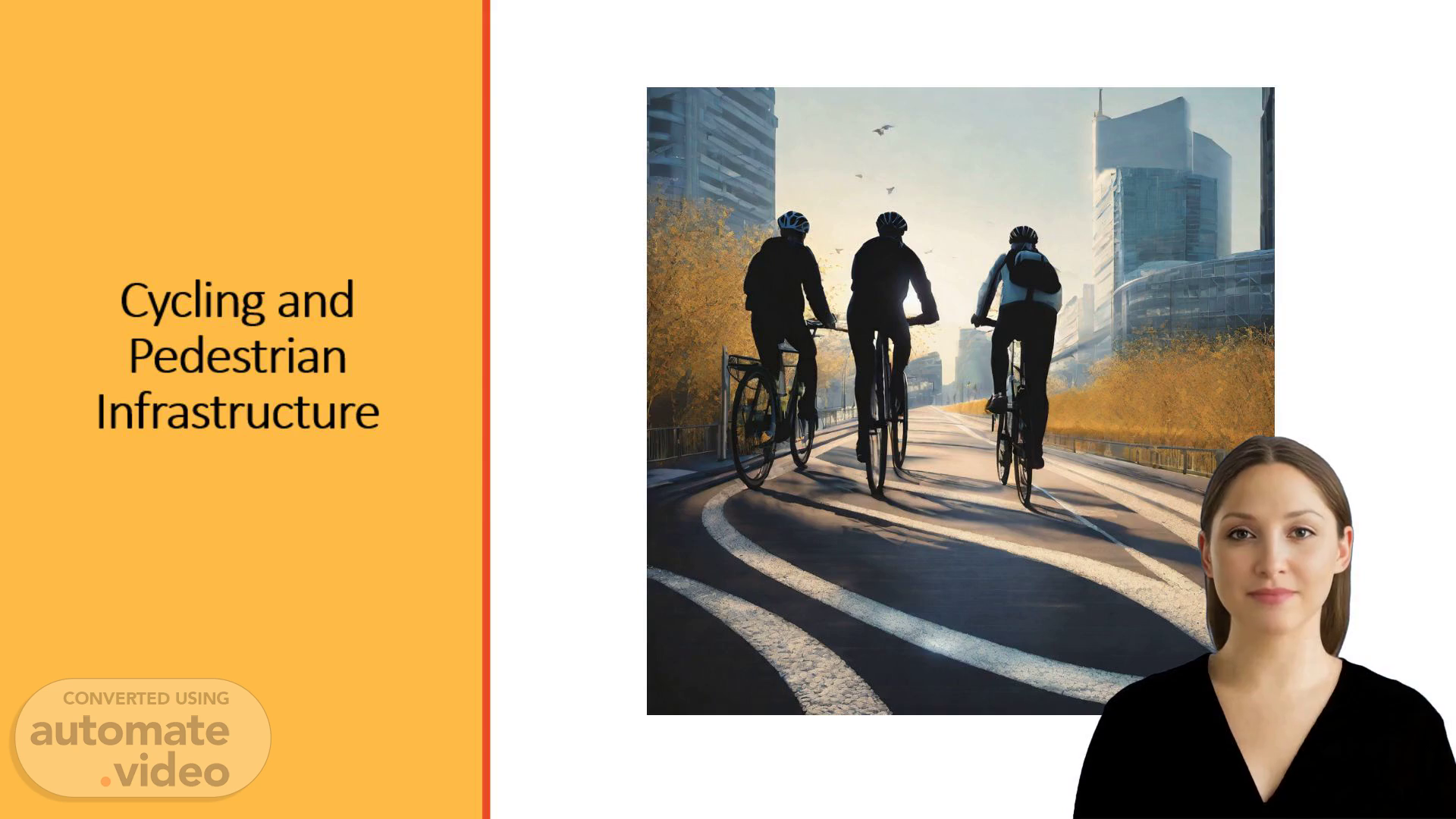
Cycling and Pedestrian Infrastructure
Scene 1 (0s)
[Virtual Presenter] Good morning everyone. We are here to discuss how we can improve our community through greater access to cycling and walking infrastructure. This could bring about physical and mental health benefits, reduce traffic congestion, decreases carbon emissions, and foster a closer-knit community. However, before we can implement these changes, there are various challenges and obstacles we need to consider. Let us take a closer look at these issues..
Scene 2 (32s)
[Audio] Investment in cycling and pedestrian infrastructure is essential for a sustainable transportation system in any city or town. Not only does it reduce congestion and pollution by giving people reliable alternatives to cars, but it also makes communities more walkable and livable by providing accessible pathways for people of all ages and abilities. Additionally, investing in cycling and pedestrian infrastructure is a cost-effective way to promote sustainable transportation and healthy, livable communities..
Scene 3 (1m 5s)
[Audio] Physical and mental well-being can be maintained by cycling and walking. Research has demonstrated that consistent physical activity in the open air can lessen strain and enhance disposition. It is also a verified approach to limit traffic jams and carbon emission. Furthermore, cycling and walking can encourage a higher degree of collaboration from citizens to local businesses, parks, and other close-by assets. Installing cycling and pedestrian infrastructure is a significant step to establishing more socially and ecologically responsible communities..
Scene 4 (1m 44s)
[Audio] When improving cycling and pedestrian infrastructure, there are several challenges that need to be addressed. Resistance from motorists and local businesses may be caused by worries about increased traffic congestion or lessened parking spaces. Another barrier could be a lack of funding for implementation and maintenance. Furthermore, successful implementation relies on extensive planning and coordination between government agencies, transportation departments, and community organizations..
Scene 5 (2m 17s)
[Audio] There is an urgent need to address the lack of dedicated lanes, poor signage, and limited connectivity for safer cycling and pedestrian infrastructures. This poses a direct danger to cyclists and pedestrians, as they are forced to share the road with vehicles, making it difficult to navigate safely. Therefore, a comprehensive system of paths and dedicated lanes with clearly marked signage is necessary to provide a safe and efficient infrastructure for active transport..
Scene 6 (2m 49s)
[Audio] Cycling and walking are two of the most popular forms of transportation across the globe, and they can be made even safer through investments in infrastructure designed explicitly for them. Bike lanes provide a protected and dedicated course for cyclists to ride, while pedestrian crosswalks guarantee safe crossings for pedestrians. Additionally, shared-use paths provide both cyclists and pedestrians their own path for non-motorized transportation. The goal is to build a safer and more comfortable transportation atmosphere for everyone..
Scene 7 (3m 25s)
[Audio] Safety has to be taken into consideration when planning cycling- and pedestrian- friendly infrastructure. Traffic calming measures should be implemented to lower vehicle speeds and signage and markings should be used to show routes, crossings and shared spaces. Furthermore, educational programs should be generated to ensure safe cycling and pedestrian practices. Thus, safety must remain a major point when aiming for the development of cycling and pedestrian infrastructure..
Scene 8 (3m 57s)
[Audio] As cities continue to grow, Cycling and Pedestrian Infrastructure are becoming increasingly vital. Examining successful case studies such as those of Amsterdam, Copenhagen and Portland, it is evident that when cities invest in cycling and pedestrian infrastructure it can lead to enhanced safety along with a decrease in car usage and a rise in cycling rates. From Amsterdam to Copenhagen to Portland, through creating cycling lanes, pedestrian-friendly streets, and bike-sharing programs, cities can create a more cycle and pedestrian friendly atmosphere..
Scene 9 (4m 34s)
[Audio] In order to create safe and healthy cities, it is essential to implement cycling and pedestrian infrastructure. Funding for infrastructure projects must be increased to build bike lanes, sidewalks and crosswalks, as well as to maintain and repair existing ones. To ensure safety and accessibility, comprehensive planning and design guidelines must be met, including standards for bike lane width, sidewalk accessibility and intersection design. Involving local communities to address concerns and gather input on cycling and pedestrian infrastructure is also necessary for success. By working together, our cities can be made safe and healthy for everyone..
Scene 10 (5m 19s)
[Audio] When it comes to long-term, sustainable transportation solutions, cycling and pedestrian infrastructure must be taken into account. Bike-sharing programs should be expanded and connected networks of bike lanes and pedestrian paths established in order to make cycling and walking more accessible and secure. Moreover, cycling and walking must be incorporated into urban planning so that active transportation can be presented as a realistic and sustainable form of travel. By making the required measures towards a better future, we can guarantee that everyone will have safe and dependable transportation choices..
Scene 11 (5m 59s)
[Audio] Active transportation, including cycling and walking, is gaining traction as a sustainable transportation option globally. To further encourage active transportation, infrastructure should be improved with dedicated bike lanes, pedestrian paths, bike-sharing stations, and bike racks. Safety should be improved through traffic calming measures and lighting up sidewalks. To make active transportation more attractive, public awareness campaigns should be undertaken to inform people of its benefits, and partnerships with local businesses formed to provide incentives. The aim for the future is to ensure that active transportation is a viable option for everyone..
Scene 12 (6m 44s)
Thank You.